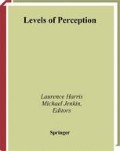Conclusions
Our inability to explain in concrete terms how lightness is computed by the visual system has left us with an uneconomical and unfalsifiable dual explanation, attributing some aspects of lightness to bodily processes and others to mental processes. The failure of low-level accounts based on contrast mechanisms to cope with either the results of lightness constancy work in 3D displays or the new wave of configuration-based lightness illusions has led to a renewed interest in a dual high-low account. But this retreat is not necessary. The feasibility of a coherent monistic account was shown by Gestalt theory early in this century, and recent work on lightness anchoring has extended this approach and made it more concrete. Indeed, in a recent series of experiments testing variations on simultaneous contrast, the anchoring approach was shown to make specific predictions while the low-level account did not.
Access this chapter
Tax calculation will be finalised at checkout
Purchases are for personal use only
Preview
Unable to display preview. Download preview PDF.
References
Adelson, E. (2000). Lightness perception and lightness illusions. In M. Gazzaniga (ed.), The Cognitive Neurosciences, 2nd ed., pp. 339–351. MIT Press: Cambridge, MA.
Agostini, T. and Bruno, N. (1996). Lightness contrast in CRT and paper-and-illuminant displays. Percept. Psychophys., 58: 250–258.
Agostini, T. and Galmonte, A. (2002). Perceptual grouping overcomes the effect of local surround in determining simultaneous lightness contrast. Psycholog. Sci., 13: 88–92.
Arend, L. E. and Goldstein, R. (1987). Simultaneous constancy, lightness, and brightness. J. Opt. Soc. Am. A, 4: 2281–2285.
Boring, E. (1942). Sensation and Perception in the History of Experimental Psychology. New York: Appleton Century Crofts.
Bressan, P. (2001). Explaining lightness illusions. Percept., 30: 1031–1046.
Bressan, P. and Actis-Grosso, R. (2001). Simultaneous lightness contrast with double increments. Percept., 30: 889–897.
Cornsweet, T. N. (1970). Visual Perception. New York: Academic Press.
De Valois, R. L., and De Valois, K. K. (1988). Spatial Vision, Oxford: Oxford University Press.
Economou, E., Annan, V. and Gilchrist, A. L. (1999). Contrast depends on anchoring within perceptual groups. Invest. Ophthal. Vis. Sci. 39: S857.
Freeman, R. B. (1967). Contrast interpretation of brightness constancy. Psychol. Bul. 67: 165–187.
Gelb, A. (1929). Die “Farbenkonstanz” der Sehdinge. Handbuch der normalen und pathologischen Psychologie. W. A. von Bethe. 12: 594–678.
Gilchrist, A. L. (1979). The perception of surface blacks and whites. Sci. Am. 240: 112–123.
Gilchrist, A. L. (1980). When does perceived lightness depend on perceived spatial arrangement? Percept. Psychophys., 28: 527–538.
Gilchrist, A. L. (1988). Lightness contrast and failures of constancy: a common explanation. Percept. Psychophys. 43: 415–424.
Gilchrist, A. L., Delman, S. and Jacobsen, A. (1983). The classification and integration of edges as critical to the perception of reflectance and illumination. Percept. Psychophys. 33: 425–436.
Gilchrist, A. L., Kossyfidis, C., Bonato, F., Agostini, T., Cataliotti, J., Li, X., Spehar, B., Annan, V., Economou, E. (1999). An anchoring theory of lightness perception. Psychol. Rev. 106: 795–834.
Heinemann, E. G. (1955). Simultaneous brightness induction as a function of inducing-and test-field luminances. J. Exp. Psych., 50: 89–96.
Heinemann, E. G. (1972). Simultaneous brightness induction. In D. Jameson and L. Hurvich (eds.), Handbook of Sensory Physiology VII-4 Visual Psychophysics, Berlin: Springer-Verlag.
von Helmholtz, H. (1866). Helmholtz’s Treatise on Physiological Optics. New York: Optical Society of America.
Hering, E. (1874, 1964). Outlines of a Theory of the Light Sense. Cambridge, MA: Harvard University Press.
Hurvich, L. and Jameson, D. (1966). The Perception of Brightness and Darkness. Boston, MA: Allyn and Bacon.
Jacobsen, A. and Gilchrist, A. (1988). Hess and Pretori revisited: Resolution of some old contradictions. Percept. Psychophys., 43: 7–14.
Jameson, D. and Hurvich, L. M. (1964). Theory of brightness and color contrast in human vision. Vis. Res., 4: 135–154.
Kardos, L. (1934). Ding und Schatten. Zeitschrift für Psychologie Erg. Bd 23.
Koffka, K. (1935). Principles of Gestalt Psychology. New York: Harcourt, Brace, and World.
Kozaki, A. (1963). A further study in the relationship between brightness constancy and contrast. Japanese Psych. Res., 5: 129–136.
Kozaki, A. (1965). The effect of coexistent stimuli other than the test stimulus on brightness constancy. Japanese Psych. Res. 7: 138–147.
Li, X. and Gilchrist, A. L. (1999). Relative area and relative luminance combine to anchor surface lightness values. Percept. Psychophys., 61: 771–785.
Logvinenko, A. D., Kane, J. and Ross, D. A. (2002). Is lightness induction a pictoral illusion? Perception, 31: 73–82.
Ross, W. D. and Pessoa, L. (2000). Lightness from contrast: A selective integration model. Percept. Psychophys., 62: 1160–1181.
Todorovic, D. (1997). Lightness and junctions. Percept., 26: 379–394.
White, M. (1981). The effect of the nature of the surround on the perceived lightness of grey bars within square-wave test gratings. Percept., 10: 215–230.
Whittle, P. (1994). Contrast brightness and ordinary seeing. In A. L. Gilchrist (ed.), Lightness, Brightness, and Transparency, pp. 111–158. Hillsdale, NY: Erlbaum.
Whittle, P. and Challands, P. D. C. (1969). The effect of background luminance on the brightness of flashes. Vis. Res., 9: 1095–1110.
Editor information
Editors and Affiliations
Rights and permissions
Copyright information
© 2003 Springer-Verlag New York, Inc.
About this chapter
Cite this chapter
Gilchrist, A.L., Economou, E. (2003). Dualistic Versus Monistic Accounts of Lightness Perception. In: Harris, L., Jenkin, M. (eds) Levels of Perception. Springer, New York, NY. https://doi.org/10.1007/0-387-22673-7_2
Download citation
DOI: https://doi.org/10.1007/0-387-22673-7_2
Publisher Name: Springer, New York, NY
Print ISBN: 978-0-387-95525-4
Online ISBN: 978-0-387-22673-6
eBook Packages: Springer Book Archive

